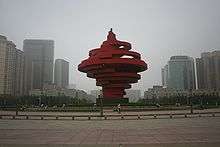May Fourth Square
Coordinates: 36°3′40.37″N 120°22′48.68″E / 36.0612139°N 120.3801889°E

May Fourth Square (Chinese: Wusi Guangchang) is a large public square in Qingdao's central business district. It is located between the new municipal government building and Fushan Bay and is composed of Shizhengting Square, the central square and the coastal park. Named after the nationwide protest May Fourth Movement that started in Qingdao, the square is best recognized by the large "May Wind" (Chinese: 五月的风), sculpture near the seaside. The square is a popular tourist destination, and is bordered by the city government to the north, the sea to the south, and residential and commercial buildings on either side. On pleasant days May Fourth Square fills with young couples on the ground and kites in the air.
History of May Fourth Square[1]
The May 4th Movement (五四运动, wǔsì yùndòng) was sparked by Article 156 of the Treaty of Versailles which transferred German concessions in Shandong including Qingdao to Japan rather than returning sovereign authority to China. Chinese outrage over this provision ignited mass student demonstrations in Beijing on May 4th, 1919 which resulted in the cultural movement know today as the May Fourth Movement. The May 4th Movement influenced the Chinese delegation not to sign the Treaty of Versailles. China declared the end of its war against Germany in September 1919 and signed a separate treaty in 1921.
References
- ↑ "May Fourth Square (五四广场) - That's Qingdao". That's Qingdao. 2016-03-06. Retrieved 2016-10-18.